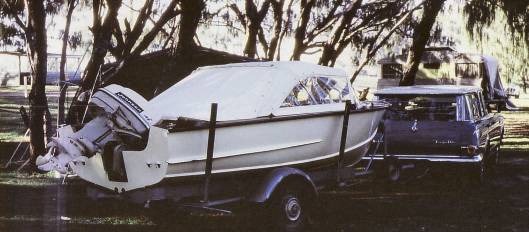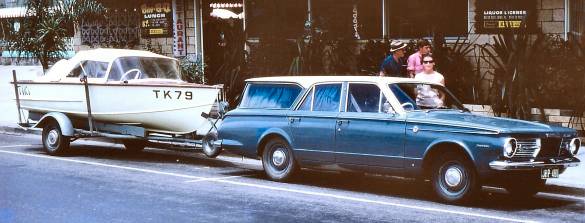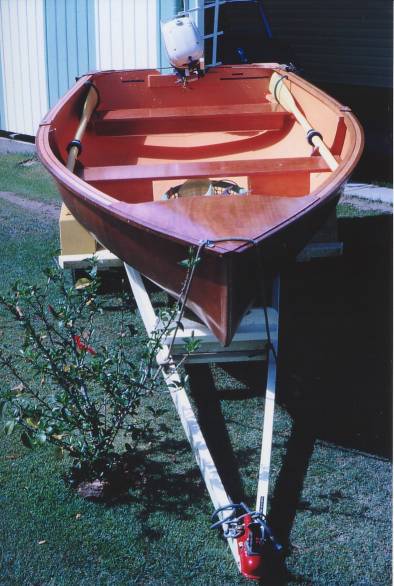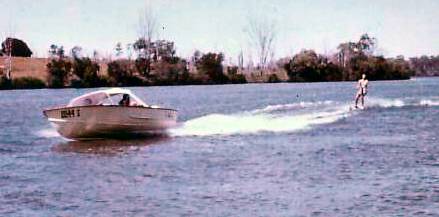Move to Queensland
By 1966 I could feel a change coming over the boating industry. A fibreglass "Flying Dutchman" had appeared and it looked good. There was a firm in South Australia, "Bell Buoy", who was turning out an attractive range of power boats and several other firms were advertising fibreglass boats. It had taken a long time, but fibreglass had arrived.
Over the last fifteen years we had built close to two thousand five hundred boats, had used an estimated one and a half million square feet of veneer, and nearly thirty tons of glue. We had reached our peak, and I felt that unless we moved with the times our business would decline, but my partner disagreed. He was quite a lot older than me and although we had got along very well together up to date, our relationship was starting to sour.
Melbourne winters seem very long and miserable, and I was getting bored. Some one suggested that we had six months winter then six months bad weather, and it did sometimes seem that way.
My wife to be, June, and I decided to have a look at Queensland, and with "Tiki" on behind we drove as far as the Whitsundays and explored the islands. We had in mind maybe building a large sailing boat for charter, so we spent some time at Shute Harbour talking to the operators there.
We were disappointed with their attitude. About ten boats were operating at that time, and all appeared to be operating at a loss and taking less than a paying load. When I suggested it would be better to get together and maybe just run three days a week each with a paying load, it became obvious that they would prefer to cut each others throats rather than cooperate.

At Elliott Heads. The campsite where we tried to sit out cyclone "Dianna".When we left, the ocean was like
the inside of a washing machine,no big waves, just turmoil.
We decided to look next at Bundaberg and had gone purposely in January to see how severe it was in the hotter months. We set up our tent at Elliot Heads in the camping grounds bordering the river and the beach, and were constantly being asked if we knew where there was a boat hire place.
Elliot Heads was an ideal place with a pleasant river, lots of fish, a popular beach, and just ten miles out of town.
We had been there a week and all of a sudden people started to move out.
There was cyclone coming. It seemed that most of the campers lived in Bundaberg and came down to the beach to live over the hot weather.
They had proper beds, tables, etc, and lots of household goods, and were moving out. Soon we had the grounds to ourselves and had to make a decision on what to do. We decided to wait and see. We were curious as to what it would be like in a cyclone. That evening, it seemed as though every lizard, cockroach, toad, and insect in the park wanted shelter in our tent.
The next morning the sea had come over the low dune, and was flooding into the caravan park. Trees and power lines were coming down, so it was time to get out!
Cyclone "Dianna" followed us that day all the way down to Coffs Harbour, where we stayed that night, only to wake up the next morning in a sea of water. We were flood bound for two days.
Our experiences with the cyclone and floods didn't discourage us from wanting to live in Queensland, so we went home and sold up everything, including our share of the business and headed for Bundaberg.

Coolangatta. Our first look at the Gold coast and we were not very impressed, so we carried on up to Bundaberg as planned.
In the past we had driven north up the Newell Highway, and had dismissed the Gold Coast as a tourist destination never even bothering to look, but this time it was the coast road. We stopped for some lunch at Coolangatta, and happened to comment on all the swimmers. It was August, and quite cool, the shop keeper muttered something about them being "Stupid bloody Victorians". !
In Bundaberg it didn't take long to learn to keep quiet about where we came from. We had gone looking at houses for sale, and had mentioned that we had come up from Melbourne. Having decided on two possible places, and prepared to make an offer, we found that the price of both had risen overnight; both vendors claimed to have made a mistake on the asking price, The agent confirmed later that it was because we were from the south, and so must have plenty of money. Lesson No 1: Get rid of those Victorian number plates quick.

The first hire boat. We originally had concerns about the
boats coming back on time, but there were never any problems.
The plan was to build six hire boats and put them on trailers. The fishing and crabbing was good all up the coast in protected waters.
We rented a small factory, and set up a plant to build the boats in moulded ply. I designed a big roomy twelve footer and put the first one on a timber trailer. It was nice and stable, had floatation, was easy to row, and was fitted with a small outboard.
I was informed by Harbours and Marine in Brisbane that the local harbour master would study the plans and attend to the registration as a hire boat.
A big problem: It had never been done before. Hire out boats on trailers? No it can't be done! There is nothing in the regulations about it, so it can't be done!
We took the matter up with H&M in Brisbane, and in the mean time asked the Harbour Master to at least go ahead with the boat approval, and of course there were big problems there also. Why weren't there hanging knees supporting the deck? And where were the ribs? It took three months to sort those items out. Things were getting pretty heated, and the last thing that seemed of really great concern, was the anchor rope.
It had to be, "Ten fathoms of one and a half inch diameter Manilla".
If you have ever handled one and a half inch diameter rope on a twelve foot dinghy you will understand why I really got upset this time.
A series of strongly worded letters to the secretary of H&M finally got it all sorted out.
The Harbour Master was not exactly loved by the local professional fishermen either.
Our hire dinghy's were allowed to range as far afield as "1770" in the north and Hervey Bay to the south, and became very popular as the cane workers were usually laid off between January and April.
There were just two problems that we hadn't taken into account!
Sunday was the most popular day, and the best time to go fishing was early, and that was 4am. The other thing we hadn't thought about was, people would hire a boat once, and then want to buy it.
While we had the set up to build these boats, why not build a few to sell?
Then we were asked, "How about building a fast serious fishing boat?"
There was a big old service station on the road out to Bargara available to rent, so we took that, and we were in business again. I took on some staff and June set up an office. June had run our office in Melbourne for several years before we headed for Queensland.
We designed a big sixteen foot, deep V runabout suitable for outside fishing, and that became very popular. We also built some one off bigger boats.
We had been invited to race our runabout in the Maryborough power boat marathon. This race was started in the Mary river at Maryborough, ran down the river to Mary Heads, around the west side of Woody island, and on up into Hervey Bay - a race distance of about fifty miles.
On the day of the race there was a strong North Easterly blowing, and it was to be a handicap start. Some twenty boats lined up. Some were proper race boats with the latest 150 HP outboards and the "Haines Hunter" racing team were there. Our little boat with a forty Hp motor was one of the first off, and we had just made the river heads, when one of the bigger boats came roaring past. The boat hit the big swell running down through the strait and nosed dived into the next swell, turned around and headed back home.
We kept on going past Woody Island, and on in to the bay. The further we went the rougher it got and although there were much faster boats in the race we thought it strange that none had passed us.
The race instructions were, "Continue on a northerly course for three miles, beyond Woody Island and round a marker boat showing a red flag." Conditions had become very rough, and I asked June to go aft and change over fuel tanks. Just then we hit a big wave, there was a yell from June. I looked around, and there she was straddled over the motor.
We hunted for that marker boat, but couldn't find it, and finally had to turn around and head back with a very uncomfortable sea on our tail.
June became very seasick, which was strange, as we had been through conditions just as bad before without any problems.
When we got back to the ramp at Maryborough most of the boats had already gone home, and we were told that the race had been called off because the anchored marker boat was taking so much water over its bow that it was in danger of sinking, and had to go home.
June was sick all the way home and sick again the next morning, so off to the doctor, sea sickness doesn't last that long! It turned out that it wasn't sea sickness; June was pregnant!

The Deep vee fishing boats we built also made quite good ski boats on the Burnett river.
During the four years in Bundaberg:
- Our Son was safely born in the Bundaberg hospital.
- Decimal currency had come in, even though dollars were being called Quids.
- Motorists were still arguing over right of way rules on roundabouts.
- Man had landed on the moon, although some believed that it wasn't for real.
- And the Harbour Master was still fretting over the ten fathoms of one and a half inch diameter Manilla anchor rope.
There hadn't been another cyclone, nor much rain over that time either, and the district was in drought. Almost no cane was harvested in the last cutting season, and a lot of workers were moving out.
Our staff were interested in taking over the business, so we decided it was time to move on.